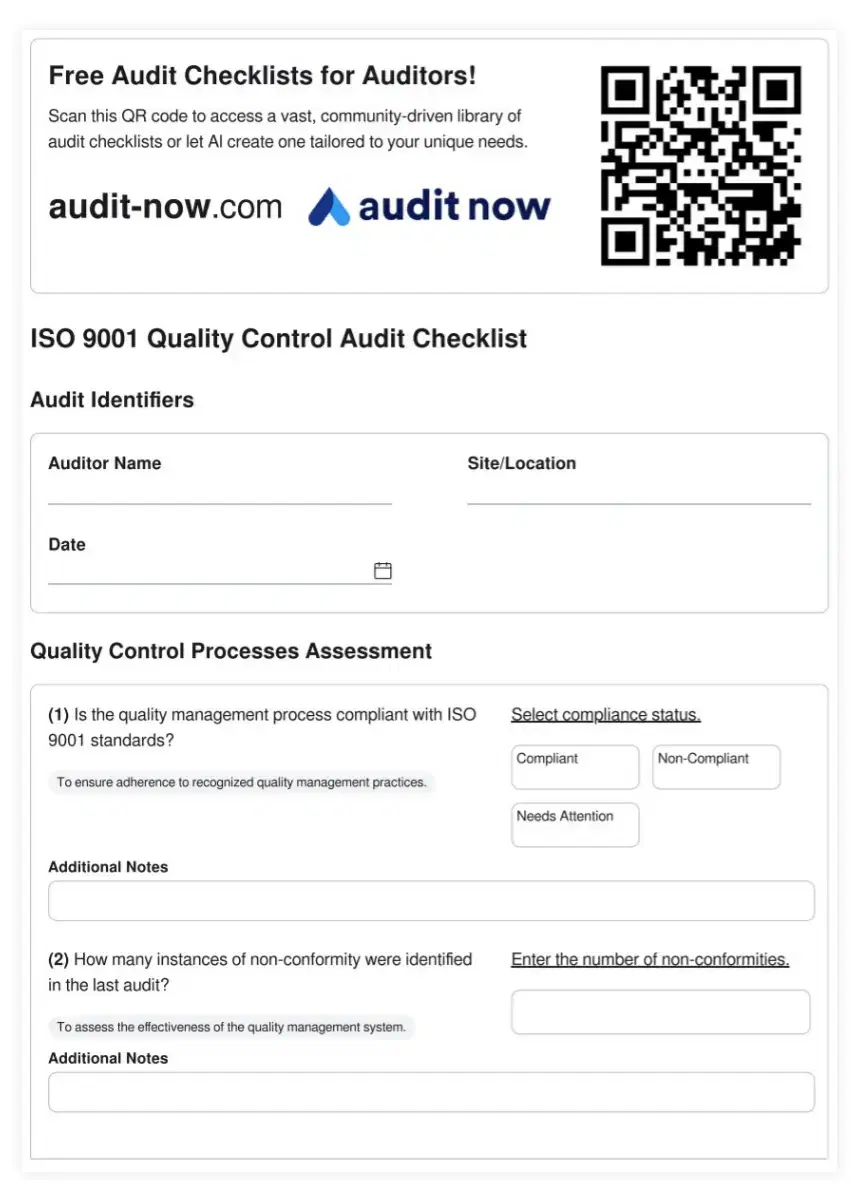In today’s fast-moving food industry, efficient restaurant inventory management is the key to staying profitable and consistent. This guide explores how modern restaurants can balance cost control, food quality, and smart technology to build smoother, data-driven operations.
02 Nov 2025
•
Beril Işık

Featured Checklist

Restaurant Inventory Management and Cost Control Audit Checklist
Effective inventory management and cost control are vital for the financial health and sustainability of any restaurant. This comprehensive Restaurant Inventory Management and Cost Control Audit Checklist is designed to help restaurant owners, managers, and financial controllers assess and optimize their inventory practices, purchasing procedures, and overall cost management strategies. By focusing on key areas such as stock rotation, supplier relationships, waste reduction, and financial tracking, this checklist aids in identifying inefficiencies, preventing losses, and maximizing profitability in the competitive hospitality industry.
In the restaurant business, profit margins are tight. And efficiency is everything. One of the biggest factors that can break profitability is restaurant inventory management.
It’s more than counting supplies. It’s about maintaining the right balance between availability and quality. Done right, inventory management helps restaurants reduce waste. It also cuts costs, and keep operations running without problem.
In this guide, we’ll explore what restaurant inventory management is. Besides, the reasons why it matters. Also how to optimize it for lasting success.
Restaurant inventory management refers to the process of tracking ingredients for daily operations. It ensures that you have enough stock to meet customer demand. As a restaurant manager, you need to do this without over-ordering or letting items expire.
Efficient restaurant inventory management starts with understanding what you’re tracking. Every ingredient, beverage, and supply in your kitchen represents important details. Effective management of these resources ensures smoother operations. This leads to consistent food quality.
When managers grasp the fundamentals, they can build systems. These systems help reduce waste, prevent shortages, and strengthen profitability across every shift.
Key functions of effective inventory management include:
When managed in a right manner, inventory becomes a strategic asset. It helps restaurant managers maintain consistency in food quality.
With Audit Now, restaurant managers can manage inventory in an easier way. They don't rely on paper checklists. They can track stock levels, expiry dates, and supplier deliveries in one place.
Real-time updates help prevent shortages, reduce waste, and keep kitchen operations consistent. All the steps save time and improve visibility across every shift.
Digitize your stock checks and keep every shift on track with Audit Now
Start Now
Inventory management keeps a restaurant running withday. It ensures that ingredients are always available when needed. It also prevents waste, and keeps the kitchen organized.
When the staff track stock levels, they spend less time searching for items. So, they can spend more time focusing on guests.
Good inventory control helps every shift run without any problem. It saves time, reduces stress, and improves the dining experience.
Inventory isn’t only about control. It’s about optimization. Restaurants that track inventory in a regular basis can improve menu planning. They also can reduce food costs, and increase customer satisfaction.
Here’s how:
Well-managed inventory ensures that restaurants remain agile. It also shows that it is ready to adapt to fluctuations in demand, supply chain delays, or new menu launches.
Strong inventory management depends on having the right systems in place. It’s not about counting ingredients. It’s about knowing where everything is, how much you have, and when to reorder.
Restaurants can maintain control and prevent daily disruptions. They need to focus on a few key components like tracking methods and accurate reporting. When these elements work together, the entire operation becomes more predictable and efficient.
Every restaurant needs a reliable system for tracking and managing its inventory.
The most successful restaurants follow structured processes and leverage technology to stay consistent.
Key components include:
The restaurants need to take care of these components. So, they can maintain control over both quality and costs.
Even well-managed restaurants face inventory challenges. Mistakes in counting or last-minute supplier issues can throw off daily operations. Recognizing these problems early helps managers find practical solutions. So they can keep everything running without any problem.
Even the most experienced managers face challenges. Manual tracking systems, missing data, and inconsistent procedures can lead to costly mistakes.
Typical challenges include:
Digital restaurant audit softwares help resolve many of these issues. They automate the data entry and centralizes visibility.
Digital inventory management tools are transforming restaurant operations worldwide. Managers now use smart software to track supplies in real time, not spreadsheets. These tools reduce human error, automate audit and inspection tasks. So every ingredient becomes traceable.
With platforms like Audit Now, restaurants can simplify inventory tracking. They can also prevent waste, and maintain full compliance. All while improving efficiency and profitability.
Modern restaurant operations follow the digital transformations. Audit Now enables restaurants to move away from paper-based logs. They move toward automated, data-driven systems.
These tools allow teams to:
With real-time data available in a dashboard, managers can feel operational efficiency. They can act fast when discrepancies arise.
A clear and consistent inventory process is the backbone of successful restaurant management. It helps teams know what’s in stock, what’s running low.
Managers can ensure every ingredient and supply has a point. They do this by following a structured system supported by digital checklists. This improves both accuracy and profitability.
Consistency is key to controlling costs and maintaining quality. A structured process keeps everyone aligned.
Here’s a simple framework:
By following a disciplined approach, restaurants avoid last-minute shortages and unexpected waste.
Integrating audit systems into inventory management brings structure and accuracy. It also brings real-time visibility to restaurant operations. Managers can use digital audit tools to verify stock levels. It also helps flag discrepancies.
Audit Now simplify this process by turning inventory checks into actionable insights. It helps teams stay compliant, reduce waste, and make smarter ordering decisions.
Inventory audits ensure transparency and accountability across departments.
Audit Now transforms inventory checks into actionable insights.
Benefits include:
These systems simplify reporting. It also ensures that all processes meet regulatory and brand standards.
Analytics help restaurant managers make better choices using real data. By tracking what sells and what goes to waste, managers can plan smarter and reduce costs.
Audit Now make it easy to see trends, improve ordering decisions. It also keeps operations running.
Analytics are an important part of running a modern restaurant. By reviewing inventory data, managers can easily see which menu items perform best. They also see when demand increases, and how reliable their suppliers are.
Advanced systems like Audit Now allow managers to:
With these insights, restaurants can make informed purchasing decisions, reduce risk. They can also maintain steady profitability.
Continuous improvement keeps restaurants growing stronger over time. Regular audits and reviews help managers spot small issues. By building a culture that values feedback, restaurants can maintain high standards. They can also deliver better results every day.
The best restaurants treat inventory management as an ongoing process. It is not a one-time task. Regular audits and performance reviews help sustain excellence.
Regular audits and performance reviews help sustain excellence.
A culture of continuous improvement encourages teams to:
This proactive approach strengthens compliance, enhances accountability, and supports long-term growth.
Restaurant inventory management is the foundation of operational success. It connects cost control, quality, and guest satisfaction under one framework.
By combining structured processes with Audit Now, restaurants can move beyond manual tracking. They can achieve precision, transparency, and profitability. From the kitchen to the storeroom, every data point tells a story. The smarter you manage it, the more your restaurant thrives.
Audit Best Practices: Learn More
What Does a Restaurant Manager Do? Key Responsibilities and Best Practices
The Complete Guide to Restaurant Inventory Management in 2025